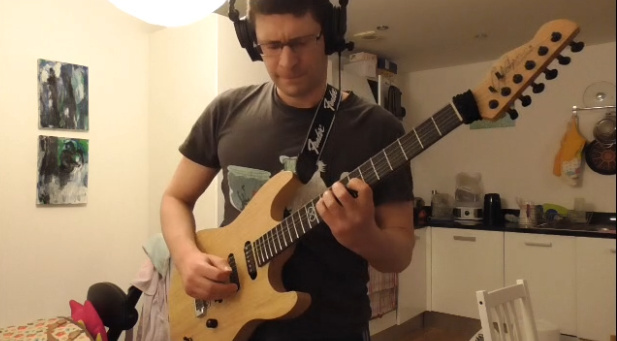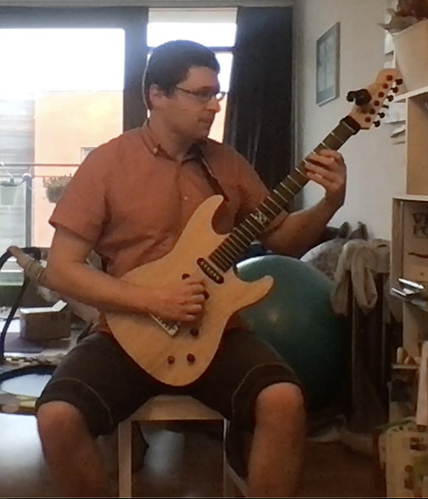How exactly are you positioning that Warlock on your leg? (Wondering if you actually put your leg into that scoop-out where the end pin would be…?)
Holy S**t!
I own guitars cheaper than that 
This has never been an issue for me, I just use a strap and I’m not thinking about all this anymore.
Get on with your practice you sissies 
You’re a lucky man @twangsta, if you found a comfortable posture so quickly!
When I did that in high school and started practicing 5h/ day, after a few weeks I had a continuous back pain all day long! I ended up almost quitting guitar altogether!
I think it’s very important to find an ergonomic solution before starting the hard work.
In fact I recently developed the hypothesis that the best thing is to probably have many playing postures: sitting, standing, sitting with the other leg, [what else???], and basically never spend too long on each one.
I would like to bring this to the attention of the mods as clearly being hate speech
HAHAHAHAHAHAHAHAHA just kidding 
This. I always play electrical in the classical position and I always use a strap. My body alignment is always dead center. I think if you were to not use a strap and attempt a classical position with an electric guitar, the results would not be good. The body of the electric is not big enough to get it into a true classical position. To compensate you’d need lift your left leg very high, or lean over more to reach the instrument. Either of which would ultimately become uncomfortable.
All those years ago when I was a young man of 17 and was taking classical lessons from Julian Gray (who would go on to become the department chair at Peabody Conservatory) he taught me to sit comfortably with good posture and bring the instrument to you, never position yourself to the guitar. I know there are many areas where electric and classical have about as much in common as ham and hamburgers, but I genuinely think this is good advice, regardless of which posture suits you, your instrument and your genre.
That said, I really want a performaxe now lol! I actually use a similar (MUCH CHEAPER) device when I play true classical…it would never work on the electric though.
I’d say if anyone plays “true” classical and is still using a footstool…save your lower back and try one out. The classical purists may glare at you but screw them.
I would also like to bring that last sentence to the attention of the mods as hate speech
Oh wow, pretty on topic. The amazing @Tom_Gilroy just put together (another) reallyhelpful video on guitar positioning and fretting postures:
Very good stuff, thanks Tom!
I tried this but still don’t understand how it can possibly work (for me, that is  )
)
Again I’m right handed. Because the right leg is in the way, the guitar gets pushed so far to the left that I have to turn my body to the side, enough to cause discomfort after just a couple of minutes.
When I stand up with the strap things get better, as the guitar is allowed to go a bit past the right leg and things are reasonably centered:

Ah I see. I guess I have my strap up just a little higher than you. The body barely touches my right leg. Actually if I stop slouching and sit up straight like I ought to, it doesn’t touch my left leg at all 
I think I see what you mean! As far as I can see that position (with the guitar very high up) is certainly good for some things (e.g. left hand stretches, reching higher frets) - but I’m pretty sure it’ll make other things very much harder - like strumming A, D and G chords in open positions - or generally fretting stuff in the low frets 
I am not an ergonomic expert, but I sit in that style:
Your left knee doesn’t seem to be high enough, as no hands still support the guitar. You are correct that twisting is bad, so why are you twisting, what problem is the twisting solving? I trust that there is no space between the guitar and your torso? Also, look at the angle of your left elbow, and why is it so far away from your torso?  Your right arm looks good…
Your right arm looks good…
Thank you @kgk - very valid questions and I don’t know the answer - worth investigating further  But I can tell you that the fretboard feels “too far to the left” no matter what I try (I may not have tried enough).
But I can tell you that the fretboard feels “too far to the left” no matter what I try (I may not have tried enough).
It must be said that the chair I’m using is also not optimal for the task (flat with no padding).
For completeness, here’s what my posture looks like with the performaxe at the highest setting. Different guitar but same strat-style body. I hope these Images are at least helpful for people to understand what not to do 
I’ve actually been doing the “super high strap sitting with the guitar center” thing for a bit now, I caught myself thinking about it the other day and was gonna post about it in this topic again! You can see it in my videos.
Ah! So if there was a vector coming out of your chest, and a vector along the guitar neck, for me their dot product is zero, and for you it is not! Your left elbow seems (by my standards) to be quite straight to reach the distant neck. So what happens if you bend your left elbow much more, and bring the neck in closer? (Hopefully the description made sense, but it’s easy to mark up the photo that you provided.)
One sentence summary: Your guitar headstock seems to be really far from your left shoulder.  Indeed, I think that you are twisting in the “classical” style because you’re trying to get your left shoulder away from the headstock.
Indeed, I think that you are twisting in the “classical” style because you’re trying to get your left shoulder away from the headstock.
Now we’re talking 
Ha, you cracked it thank you! I think my whole technique is indeed built around that configuration.
I guess this means - if I want to keep doing the same thing - that my currently optimal solution [local optimum of course - not global  ] is to alternate between standing and the performaxe position.
] is to alternate between standing and the performaxe position.
Most likely personal. I think it’s just all the years I played (or I guess I should say attempted to play) ‘true’ classical on a classical guitar, everything just feels right to me in that position. Open position chords, even chromatic scales on the low frets. For what it’s worth, it doesn’t matter though - I still can’t play most of the stuff you can lol! What you’re doing is clearly working!
Left hand: your fretting hand (edit: I said picking hand, I mean fretting … ) elbow should be closer to a right angle. That fretting hand is giving me pains looking at it, you’re in a classical position but with electric, it’s not necessary. Straighten the wrist, means try to get your thumb higher up on the back of the neck, def never below the half line.
[edit: reasoning… clasical guitar fretboard = wide chopping board, electric no so much.
Also, the straight wrist helps with vibrato (twisting action) & bending (push/pull action) though in reality it’s a mix of both, but twist more than push/pull for most things, fulcrum is the thumb duh ]
Right hand: It’s in a right angle; should be 135 degrees approx.
[edit: reasoning… uses more body chi, improves angle of attack for me. I actually realized this going from the Strat to the LP, diff bodies, realised the whole guitar position revolves around my picking hand angle of attack on the strings, the rest will follow.]
All this means your headstock is too high and put your guitar slightly to your right against your right leg. It’s ok if it tilts a bit forward from the bottom.
[edit: if necessary tuck your right leg under the chair to get the right vibe, then you can adjust your seating apparatus accordingly.]
Bring your arse upfront a bit and sit back more. use a small cushion for your lower back if needed.
[edit: sit back means, keep your shoulders back, arse in front so your body is tilting back, it’s also a counter balance for the guitar.]
These are my recommendations, hope they help.
I think it’s more likely that he’s trying to maintain a preferred right arm position. Pulling the headstock closer (dot product with chest normal vector = 0) would require him to thrust his right elbow forward by rotating his arm at the shoulder, which would then require modifications to some combination of his right elbow angle, wrist angle, and/or picking mechanic, which I’m guessing he wants to avoid. Twisting his torso moves his right shoulder forward so that his upper arm can drop down to a more neutral and comfortable position.
At least that’s why I do it.
One of the big differences between acoustic and electric posture comes from the thickness of the guitar body, which seems to require more of the right elbow thrust in any sitting position. To someone who is more habituated to a thinner bodied electric, maybe that thrust feels like unnecessary tension that should be eliminated in the search for easy.
I also find that there are fretting-hand benefits to the forward-thrusted headstock. Specifically, access to upper frets requires less radial wrist deviation. The effect on the fretting wrist of pushing the headstock forward is very similar to the effect of elevating the headstock in that regard.
Again, just my personal experience. Maybe this applies to Tommo, maybe not.
Like this: https://www.youtube.com/watch?v=YYc9o9ROOZ8
You don’t even have to hold the guitar in that position - it locks into your legs.
That’s what I see too. @tommo, I also notice that there’s a pretty big gap between your elbow and your torso. I think conventional wisdom for “classical” posture (someone correct me if I’m wrong), is for the elbow to stay closer to the torso, with reach toward the nut achieved by external/lateral rotation of the shoulder (versus abduction of the shoulder).
I mean, what you’ve been doing has produced great results, so I take it you’re only investigating this academically, or to better understand the hows and whys of what works for other people.
Edit: I don’t think anybody does “strict” shoulder abduction when they fret toward the nut, it will always be some blend of external rotation and abduction, so it’s more a matter of proportions. And I may have underestimated how much external rotation you’re doing (your “seated, classical” photo has a major shouder external rotation component, though you still seem to have quite a lot of abduction going on with the fretting shoulder too).
Further to what @kgk said, I think the many hours you put in seated with the guitar on your right leg habituated you to a fretting arm setup that was optimized for that guitar position and orientation (guitar offset to the right, neck pointed out from your chest to a significant degree).
I mostly practice standing. When I sit, I sit with guitar on the left leg and reach toward the nut via external shoulder rotation. I thought of myself as facing forward, but motivated by this thread, I examined more carefully and found I do rotate my torso slightly to the left. In my case, that torso rotation doesn’t result in any discomfort. When I try putting the guitar on my right leg, I find that reaching toward the nut via shoulder abduction becomes more comfortable than reaching via shoulder external rotation.
I also suspect that reaching toward the nut via shoulder external rotation help keep the elbow further “forward” than reaching toward the nut via shoulder abduction. This may help with keeping the wrist straight, and some casual google image searching of famous classical players seems to show a tendency for the forearm to approach the neck “from below” rather than “from behind”, at least relative to most rock players. It seems to me that approaching “from below” would make it easier to keep the wrist “straight” relative to the forearm, especially when fretting the lower pitch strings.
Final thought: reaching toward the nut via shoulder external rotation will mean that the angle of the hand will be different when fretting closer to the nut than closer to the 24th fret, while reaching via shoulder abduction should result in a more consistent hand angle. Open to opinions on whether one is better than the other, or if it really matters.
A-ha- so I’m not crazy after all. I’ll explain…
I was actually toying with the idea of flipping a lefty Squier upside down and cutting a scoop into what would now be the lower treble bout from righty persepctive, so it would cup the thigh. The idea being to solve the problem that I think a lot of us have while sitting: the right shoulder hikes up too high (in an effort to position the picking hand correctly). It would be my practice (while-sitting) guitar.
That seems to be what the Warlock accomplishes (aside from looking righteously metallic;) Check out the guy’s right shoulder - ahh, the comfort.




